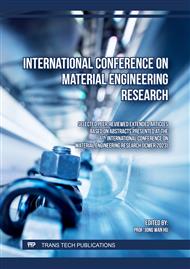p.71
p.77
p.85
p.91
p.99
p.107
p.117
p.123
p.131
Pectin/PVA-Borax Hydrogel with Self-Healing Ability
Abstract:
Hydrogels are polymers with soft and high-water absorption characteristics similar to biological tissues, leading to several potential applications, such as artificial organs, drug delivery, tissue engineering, and strain sensor. Interestingly, hydrogels can be designed to heal themselves after being damaged. In this research, hydrogels with self-healing ability from pectin and polyvinyl alcohol were prepared by simple physical mixing. Borax was used as a crosslinking agent to obtain crosslinked hydrogel structure by the formation of dynamic boron ester bonds. Glycerol was also added to the hydrogels as an anti-freezing agent and a stabilizer. The microstructures, mechanical properties, self-healing ability and swelling properties of the pectin/PVA-borax hydrogels were characterized. The results indicate that the size of microporous structure, modulus, tensile strength, self-healing time, swelling, and equilibrium water content of the pectin/PVA hydrogels increases with the increasing borax contents.
Info:
Periodical:
Pages:
123-128
Citation:
Online since:
September 2023
Authors:
Keywords:
Price:
Сopyright:
© 2023 Trans Tech Publications Ltd. All Rights Reserved
Share:
Citation:



